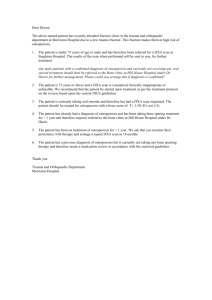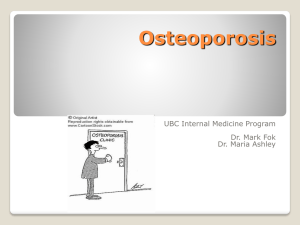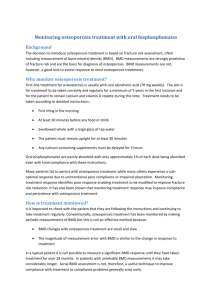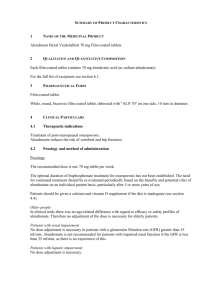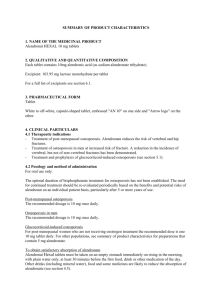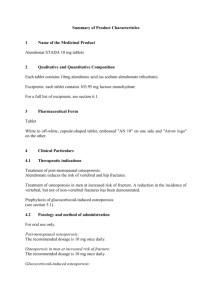Q&A 358 - NHS Evidence Search
advertisement
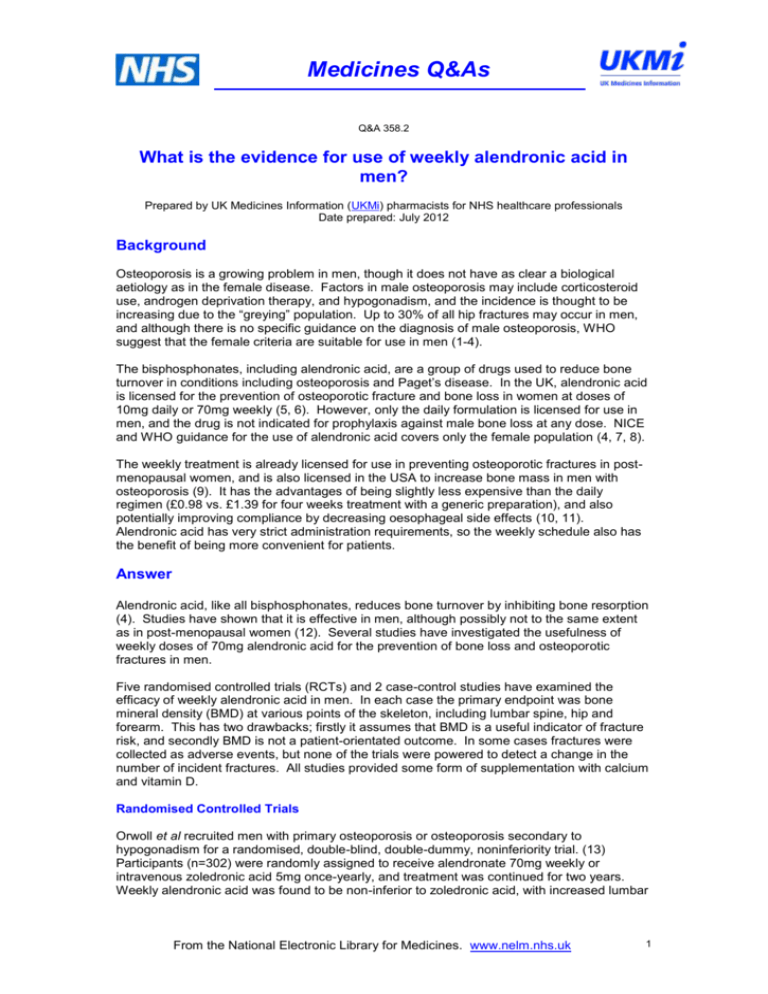
Medicines Q&As Q&A 358.2 What is the evidence for use of weekly alendronic acid in men? Prepared by UK Medicines Information (UKMi) pharmacists for NHS healthcare professionals Date prepared: July 2012 Background Osteoporosis is a growing problem in men, though it does not have as clear a biological aetiology as in the female disease. Factors in male osteoporosis may include corticosteroid use, androgen deprivation therapy, and hypogonadism, and the incidence is thought to be increasing due to the “greying” population. Up to 30% of all hip fractures may occur in men, and although there is no specific guidance on the diagnosis of male osteoporosis, WHO suggest that the female criteria are suitable for use in men (1-4). The bisphosphonates, including alendronic acid, are a group of drugs used to reduce bone turnover in conditions including osteoporosis and Paget’s disease. In the UK, alendronic acid is licensed for the prevention of osteoporotic fracture and bone loss in women at doses of 10mg daily or 70mg weekly (5, 6). However, only the daily formulation is licensed for use in men, and the drug is not indicated for prophylaxis against male bone loss at any dose. NICE and WHO guidance for the use of alendronic acid covers only the female population (4, 7, 8). The weekly treatment is already licensed for use in preventing osteoporotic fractures in postmenopausal women, and is also licensed in the USA to increase bone mass in men with osteoporosis (9). It has the advantages of being slightly less expensive than the daily regimen (£0.98 vs. £1.39 for four weeks treatment with a generic preparation), and also potentially improving compliance by decreasing oesophageal side effects (10, 11). Alendronic acid has very strict administration requirements, so the weekly schedule also has the benefit of being more convenient for patients. Answer Alendronic acid, like all bisphosphonates, reduces bone turnover by inhibiting bone resorption (4). Studies have shown that it is effective in men, although possibly not to the same extent as in post-menopausal women (12). Several studies have investigated the usefulness of weekly doses of 70mg alendronic acid for the prevention of bone loss and osteoporotic fractures in men. Five randomised controlled trials (RCTs) and 2 case-control studies have examined the efficacy of weekly alendronic acid in men. In each case the primary endpoint was bone mineral density (BMD) at various points of the skeleton, including lumbar spine, hip and forearm. This has two drawbacks; firstly it assumes that BMD is a useful indicator of fracture risk, and secondly BMD is not a patient-orientated outcome. In some cases fractures were collected as adverse events, but none of the trials were powered to detect a change in the number of incident fractures. All studies provided some form of supplementation with calcium and vitamin D. Randomised Controlled Trials Orwoll et al recruited men with primary osteoporosis or osteoporosis secondary to hypogonadism for a randomised, double-blind, double-dummy, noninferiority trial. (13) Participants (n=302) were randomly assigned to receive alendronate 70mg weekly or intravenous zoledronic acid 5mg once-yearly, and treatment was continued for two years. Weekly alendronic acid was found to be non-inferior to zoledronic acid, with increased lumbar From the National Electronic Library for Medicines. www.nelm.nhs.uk 1 Medicines Q&As spine BMD of 6.1% and 6.2% respectively in the two treatment groups. There was no significant difference in the incidence of new vertebral fractures, change in height, or markers of bone turnover between groups. In contrast a small study (n=92) by Ringe et al, published in abstract only, found that annual zoledronic acid resulted in larger increases in BMD than weekly alendronate.(14) Miller et al conducted an RCT to examine the effect of alendronic acid 70mg once weekly in 167 men with osteoporosis, diagnosed either by BMD at the lumbar spine and femoral neck, or the presence of an osteoporotic fracture (15). The study showed that 12 months of treatment significantly increased BMD at all of the sites measured, relative to both baseline and placebo. The greatest effect was seen at the lumbar spine (4.28% increase) and the least in the total body BMD (1.40% increase). Markers of bone turnover were also measured and found to decrease. Greenspan et al conducted a double-blind RCT in two phases, during which all subjects (n=112) were receiving androgen deprivation therapy (ADT) as treatment for non-metastatic prostate cancer. The first phase of the study had a similar design and results to those described above, and also showed a comparable rate of adverse effects in both placebo and treatment groups (16). In the second phase of the study, men who had previously taken placebo were switched to receive alendronic acid, and men in the treatment group were randomised to either continue with the drug, or change to placebo. At the end of the second year it was found that men who had received alendronic acid for the full two years had continued to see gains in their BMD, and that men in the placebo-alendronate group had smaller gains in BMD than the alendronate-placebo group. In other words, continuation of therapy for the full two years gave more benefit than stopping after one year, and delaying treatment was detrimental to skeletal health (17). The final RCT investigated the effect of changing the dose of alendronate from daily to weekly. A group of osteoporotic men (n=22) with androgen-repleted hypogonadism were randomised to receive either placebo or 10mg daily alendronate for 12 months. At the end of the blinded phase all men received 70mg of alendronic acid weekly, open-label. Men in the alendronate-alendronate group did not see any significant change in their lumbar spine BMD during the open-label phase of the trial, although their femoral neck BMD continued to increase slowly. Men in the placebo-alendronate saw significant gains, and at 36 months the increase in BMD at the lumbar spine reached 6.2% compared to the end of the placebo phase (p<0.05). Femoral neck BMD increased by 1.9% (P<0.05) in the same period (18). Hwang et al conducted a small (n=46) randomised, open-label study of weekly alendronate therapy in Taiwanese men who had osteoporosis but were otherwise healthy.(19) The control group received only calcium and vitamin D supplements. BMD at the lumbar spine and femoral neck increased significantly in the alendronate group compared to baseline, and compared to the control group (P<0.05). Case Control Studies The first case study prospectively examined 31 men receiving ADT for prostate cancer, with 30 historical controls. As in the other trials described treatment with weekly alendronic acid caused a significant increase in BMD at all sites measured. In this case an attempt was also made to estimate risk of hip fracture as a result of this change, which found that alendronic acid increased femoral neck BMD by 0.75g/cm 2 (P=0.03). This translated to a 0.54% decrease in risk of hip fracture (p=0.04) (20). The final study examined the efficacy of weekly alendronate in preventing bone loss in men (n=47) treated with ADT for prostate cancer. Men receiving alendronic acid experienced an increase in their BMD at the lumbar spine and hip, whereas men receiving ADT lost bone. All From the National Electronic Library for Medicines. www.nelm.nhs.uk 2 Medicines Q&As subjects lost bone at the forearm, and although men treated with alendronic acid had smaller decreases in BMD, the difference was not statistically significant (21). Summary Osteoporosis and fracture are a growing problem in the male population. Weekly doses of alendronic acid are not licensed in this group for either treatment or prophylaxis of bone loss. Several studies have indicated that alendronic acid is effective in increasing bone mineral density in men when administered in weekly doses of 70mg, and can help prevent bone loss associated with androgen deprivation therapy. Due to the very strict and inconvenient administration requirements for alendronic acid, reducing administration intervals to weekly may improve compliance. Limitations All of the studies discussed are small in size, and the majority of participants were Caucasian men. All of the RCTs received funding or other support from Merck, who manufacture and hold licenses for branded forms of alendronic acid. Merck do not recommend the use of 70mg alendronate in men, as this is outside the terms of the marketing authorisation (22). All of the studies assume that BMD is a suitable surrogate endpoint for predicting fracture risk, and although this is recommended by the WHO those guidelines are now aging. More complex tools have been developed in recent years to take into account the multifactorial nature of osteoporosis (23). The adverse effects of alendronate and necessary precautions against them are well known, and not dealt with here. Disclaimer Medicines Q&As are intended for healthcare professionals and reflect UK practice. Each Q&A relates only to the clinical scenario described. Q&As are believed to accurately reflect the medical literature at the time of writing. The authors of Medicines Q&As are not responsible for the content of external websites and links are made available solely to indicate their potential usefulness to users of NeLM. You must use your judgement to determine the accuracy and relevance of the information they contain. This document is intended for use by NHS healthcare professionals and cannot be used for commercial or marketing purposes. See NeLM for full disclaimer. References . (1) Ringe JD. Hip Fractures in Men. Osteoporosis International. 1996;Suppl. 3:S48-S51. (2) Gullberg B, Johnell O, Kanis JA. World-wide Projections for Hip Fracture. Osteoporosis International. 1997;7(5):407-13. (3) WHO. Assessment of Fracture Risk and its Application to Screening for Postmenopausal Osteoporosis: WHO; 1994. (4) WHO. Prevention and Management of Osteoporosis. Geneva: World Health Organization; 2000. (5) Merck Sharp & Dohme Limited. Summary of Product Characteristics Fosamax 10mg. Last updated 26/12/11. 2010. (6) Merck Sharp & Dohme Limited. Summary of Product Characteristics Fosamax Once Weekly 70mg Tablets. Last updated 22/02/2012. 2010. (7) NICE. TA160: Alendronate, etidronate, risedronate, raloxifene and strontium ranelate for the primary prevention of osteoporotic fragility fractures in postmenopausal women (updated Jan 2011); 2008. From the National Electronic Library for Medicines. www.nelm.nhs.uk 3 Medicines Q&As (8) NICE. TA161: Alendronate, etidronate, risedronate, raloxifene, strontium ranelate and teriparatide for the secondary prevention of osteoporotic fragility fractures in postmenopausal women (updated Jan 2011); 2008. (9) Merck Sharp & Dohme Limited. FOSAMAX® (ALENDRONATE SODIUM) TABLETS AND ORAL SOLUTION. 2010. (10) NHS Business Services Authority. Drug Tariff, July 2012 http://www.ppa.org.uk/ppa/edt_intro.htm (11) ADIS. Alendronic Acid. R&D Insight. (12) Iwamoto J, Takeda T, Sato Y, Uzawa M. Comparison of the effect of alendronate on lumbar bone mineral density and bone turnover in men and postmenopausal women with osteoporosis. Clinical Rheumatology. 2007;26:161-7. (13) Orwoll ES, Miller PD, Adachi JD, et al. Efficacy and safety of a once-yearly i.v. Infusion of zoledronic acid 5 mg versus a once-weekly 70-mg oral alendronate in the treatment of male osteoporosis: a randomized, multicenter, double-blind, active-controlled study. J Bone Miner Res. 2010 Oct;25(10):2239-50. (14) Ringe JD, Dorst A, Farahmand P. Comparing once yearly zoledronic acid with once weekly generic alendronate in the treatment of established male osteoporosis Osteoporosis International 21:S357. (15) Miller PD, Schnitzer T, Emkey R, et al. Weekly Oral Alendronic Acid in Male Osteoporosis. Clinical Drug Investigaion. 2004;24(6):333-41. (16) Greenspan SL, Nelson JB, Trump DL, Resnick NM. Effect of Once-Weekly Alendronate on Bone Loss in Men Receiving Androgen Deprivation Therapy for Prostate Cancer. Annals of Internal Medicine. 2007;146:416-24. (17) Greenspan SL, Nelson JB, Trump DL, et al. Skeletal Health After Continuation, Withdrawal, or Delay of Alendronate in Men With Prostate Cancer Undergoing AndrogenDeprivation Therapy. Journal of Clinical Oncology. 2008;26(27):4426-34. (18) Shimon I, Eshed V, Doolman R, Sela B-A, Karasik A, Vered I. Alendronate for osteoporosis in men with androgen-repleted hypogonadism. Osteoporosis International. 2005;16:1591-6. (19) Hwang JS, Liou MJ, Ho C, et al. The effects of weekly alendronate therapy in Taiwanese males with osteoporosis. Journal of bone and mineral metabolism. 2010 May;28(3):328-33. (20) Planas J, Trilla E, Raventós C, et al. Alendronate decreases the fracture risk in patients with prostate cancer on androgen-deprivation therapy and with severe osteopenia or osteoporosis. BJU International. 2009;104(1637-1640). (21) Bruder JM, Ma JZ, Wing N, Basler J, Katselnik D. Effects of Alendronate on Bone Mineral Density in Men with Prostate Cancer Treated with Androgen Deprivation Therapy. Journal of Clinical Densitometry. 2006;9(4):431-7. (22) Mapp E. RE: Fosamax® Once Weekly 70mg tablets (alendronate sodium). In: Kane N, ed. Personal communication ed 2010:1. (23) Kanis JA, Johnell O, Oden A, Johansson H, McCloskey E. FRAX and the assessment of fracture probability in men and women from the UK. Osteoporosis International. 2008;19:38597. Quality Assurance Prepared by Nancy Kane, Regional Drug and Therapeutics Centre, Newcastle upon Tyne Date Prepared July 2010, updated July 2012 Checked by Hayley Johnson, Regional Drug and Therapeutics Centre Date of check 23rd July 2012 From the National Electronic Library for Medicines. www.nelm.nhs.uk 4 Medicines Q&As Search strategy Embase ALENDRONIC ACID/ AND 70mg.af OR weekly.af [Limit to: Male] Medline ALENDRONATE/ AND 70mg.af OR weekly.af [Limit to: Male] eMC ADIS R&D Insight Internet Search (alendronic acid 70mg) www.nice.org.uk From the National Electronic Library for Medicines. www.nelm.nhs.uk 5
